Dogs
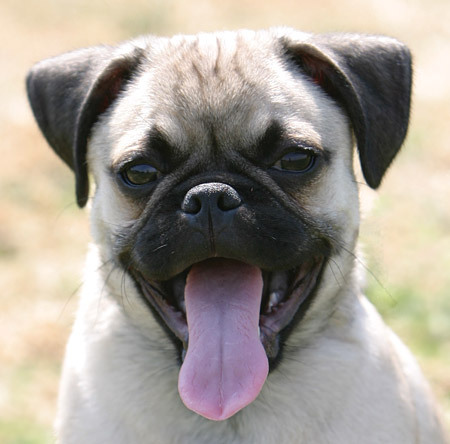
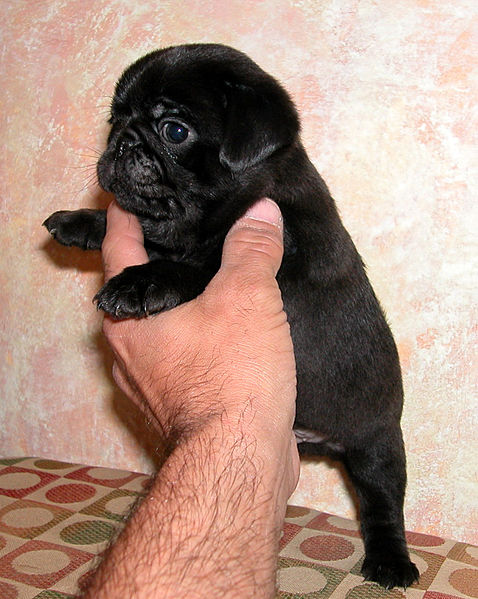

Coat and color
Their fine, glossy coats can be fawn, apricot, silver or black. A silver coat is characterized by a very light coloured coat, absent of black guard hairs. Some breeders call "smutty" Pugs silver. A "smutty" Pug typically has a very dark head, with no clear delineation at the mask, and dark forelegs. The markings are clearly defined. The trace is a black line extending from the occiput to the tail. The tail normally curls tightly over the hip.
Pugs of different coat types shed to varying degrees, but they all shed quite a bit year round. Fawn Pugs, which have both an undercoat and an overcoat, are the most notorious for shedding.Regular coat grooming can keep the shedding down.
Temperament
Strong willed, but rarely aggressive, the Pug is suitable for families with children. Pugs are tolerant of children, and sturdy enough to properly play with them. Otherwise they can be quiet and docile, but also vivacious and teasing, depending on their owner's mood. They can make good watchdogs, and they are always alert, but not yappy.
History
Origins
Bred to adorn the laps of the Chinese sovereigns during the Shang dynasty (before 400 BCE), in East China, they were known as "Lo-Chiang-Sze" or "Foo" (ceramic foos, transmogrified into dragon, with their bulging eyes are very Pug-like). The Pug's popularity spread to Tibet, where they were mainly kept by monks, and then went onto Japan, and finally Europe.
This breed may also be referred to as a "Lion Dog" or "Foo (or Fu) Dog" due to its resemblance to Chinese guardian lions just like the Pekingese dog breed from China of similar origin and resemblance to Chinese guardian lions which are considered a guardian spirit.
Sixteenth and seventeenth centuries
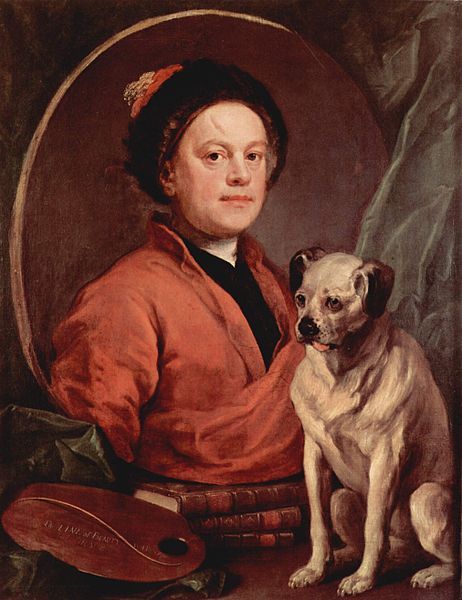
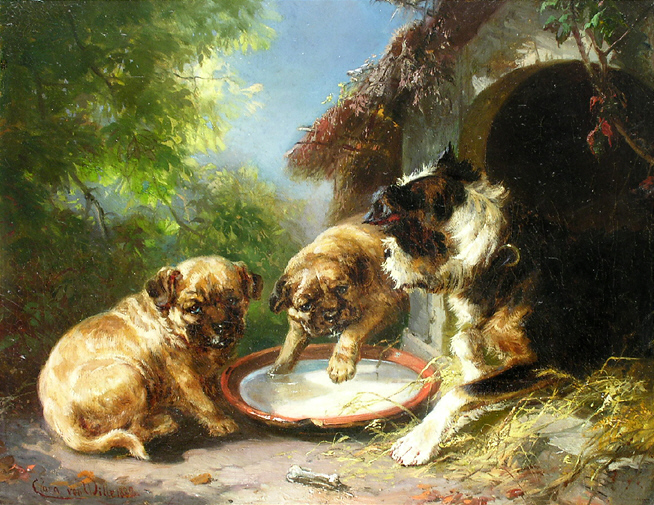
Health problems


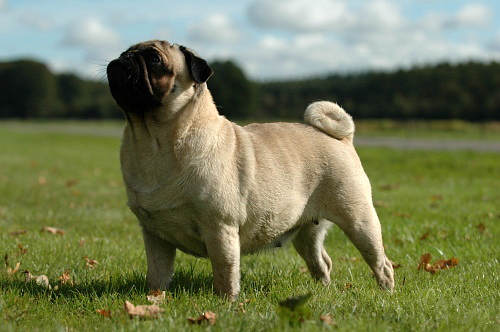
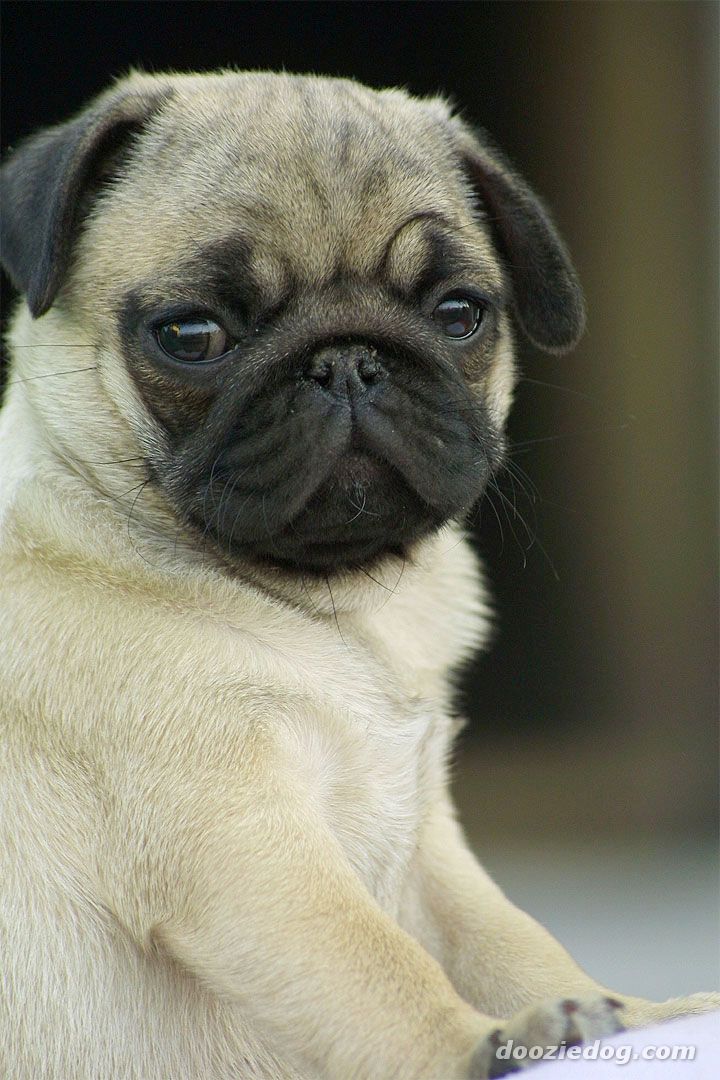
- You Be Aware Of Pug! - Family - Pets
PugOther Names : Mops, CarlinHeight : 10 - 11 inchesWeight : 13 - eighteen lbs.Colors : Silver, apricot, fawn as well as black, dark cover up as well as ears and also dark-colored trace alongside backCoat : Fine, smooth, quick plus glossyTemperament...
- The Pugs
The Pug is a small, stocky, square, thickset dog. The round head is massive with a short, blunt, square-shaped muzzle. Moles on the cheeks are considered beauty spots. The teeth meet in a slight undershot bite. The very large, prominent eyes are dark....
- Pugs - Wrinkly, Pudgy Bundles Of Joy!
Mention the name pug and people who knows a lot about dog breeds are bound to describe it with the phrase "multum in parvo" which means "much in little". True enough, there’s so much more to the small package than what meets the eye. Despite it’s...
- Pug Names And Meanings
Pugs are small dogs that have originated in China. They are one of the oldest breeds of dogs that had been popular even before 400 BC. They were kept as pets by the Buddhist monasteries of Tibet. The pugs then made an appearance in Japan and Europe....
- Pug Dog Health Issues
The pug dog is distinctly characterized by its wrinkly face. It is also commonly referred to as a toy dog because of its small size. It has a well-developed, short, and square body. Pugs possess strong and sturdy pairs of legs. They come in an assortment...
Dogs
Pug small dog breed

The Pug is a small breed of dog with a wrinkly, short muzzled face, and curled tail. The word "pug" may have come from the Old English pugg or "puge", which were affectionate terms for a playful little devil or monkey. Pug puppies are often called puglets. The breed is often summarized as multum in parvo ("much in little"), describing the Pug's remarkable personality despite its small size.
Description
Description

While most Pugs appearing in eighteenth century prints tended to be long and lean, modern breed preferences are for a square, cobby body, a compact form, a deep chest, and well-developed muscle. Breeding preference goes to "button" Pugs. The legs are very strong, straight, of moderate length, and are set well under. The shoulders are moderately laid back. The pasterns are strong, neither steep nor down. The feet are neither so long as the foot of the hare, nor so round as that of the cat; well split-up toes, and the nails black. The lower teeth normally protrude further than their upper, meeting in an under-bite.

Coat and color
Their fine, glossy coats can be fawn, apricot, silver or black. A silver coat is characterized by a very light coloured coat, absent of black guard hairs. Some breeders call "smutty" Pugs silver. A "smutty" Pug typically has a very dark head, with no clear delineation at the mask, and dark forelegs. The markings are clearly defined. The trace is a black line extending from the occiput to the tail. The tail normally curls tightly over the hip.
Pugs of different coat types shed to varying degrees, but they all shed quite a bit year round. Fawn Pugs, which have both an undercoat and an overcoat, are the most notorious for shedding.Regular coat grooming can keep the shedding down.
Temperament
Strong willed, but rarely aggressive, the Pug is suitable for families with children. Pugs are tolerant of children, and sturdy enough to properly play with them. Otherwise they can be quiet and docile, but also vivacious and teasing, depending on their owner's mood. They can make good watchdogs, and they are always alert, but not yappy.
History
Origins
Bred to adorn the laps of the Chinese sovereigns during the Shang dynasty (before 400 BCE), in East China, they were known as "Lo-Chiang-Sze" or "Foo" (ceramic foos, transmogrified into dragon, with their bulging eyes are very Pug-like). The Pug's popularity spread to Tibet, where they were mainly kept by monks, and then went onto Japan, and finally Europe.
This breed may also be referred to as a "Lion Dog" or "Foo (or Fu) Dog" due to its resemblance to Chinese guardian lions just like the Pekingese dog breed from China of similar origin and resemblance to Chinese guardian lions which are considered a guardian spirit.
Sixteenth and seventeenth centuries

The breed was first imported in the late 16th and 17th centuries by merchants and crews from the Dutch East Indies Trading Company. The Pug later became the official dog of the House of Orange.[4] In 1572, a Pug named Pompey saved the Prince of Orange's life by barking at an assassin. A Pug also traveled with William III and Mary II when they left the Netherlands to ascend to the throne of England in 1688. During this period the Pug may have been bred with the old type King Charles Spaniel, but in any event the modern English Toy/King Charles Spaniel emerged with Pug characteristics.
This century also saw Pugs' popularity on the rise in other European countries. In Spain, they were painted by Goya, in Italy Pugs dressed in matching jackets and pantaloons sat by the coachmen of the rich, and in Germany and France. Pugs appear several times as footnotes to history. Sometimes, they were used for scent hounds. They were used by the military to track animals or people, and were also employed as the guard's dogs.
Eighteenth and nineteenth centuries
This century also saw Pugs' popularity on the rise in other European countries. In Spain, they were painted by Goya, in Italy Pugs dressed in matching jackets and pantaloons sat by the coachmen of the rich, and in Germany and France. Pugs appear several times as footnotes to history. Sometimes, they were used for scent hounds. They were used by the military to track animals or people, and were also employed as the guard's dogs.
Eighteenth and nineteenth centuries

The popularity of the Pug continued to spread in France during the eighteenth century. Before her marriage to Napoleon Bonaparte, Joséphine had her Pug, Fortune, carry concealed messages to her family while she was confined at Les Carmes prison. The pet was the only recipient of visiting rights.
The English painter William Hogarth owned a series of Pugs, to which he was devoted. In 1745 he painted his self-portrait together with that of his Pug, Trump, now in the Tate Gallery, London.
In nineteenth century England, Pugs flourished under the patronage of the monarch Queen Victoria.Her many Pugs, which she bred herself, included Olga, Pedro, Minka, Fatima and Venus. Her involvement with the dogs in general helped to establish the Kennel Club, which was formed in 1873. Victoria favoured apricot and fawn Pugs, whereas the aristocrat Lady Brassey is credited with making black Pugs fashionable after she brought some back from China in 1886.
The Pug arrived in the United States during the nineteenth century(the American Kennel Club recognized the breed in 1885) and was soon making its way into the family home and show ring. In 1981 the Pug Dhandys Favorite Woodchuck won the Westminster Kennel Club show in the United States, the only Pug to have won since the show began in 1877. The World Champion (Best in Show or BIS) at the 2004 World Dog Show held in Rio de Janeiro, Brazil was a Pug, Double D Cinoblu's Masterpiece.
The English painter William Hogarth owned a series of Pugs, to which he was devoted. In 1745 he painted his self-portrait together with that of his Pug, Trump, now in the Tate Gallery, London.
In nineteenth century England, Pugs flourished under the patronage of the monarch Queen Victoria.Her many Pugs, which she bred herself, included Olga, Pedro, Minka, Fatima and Venus. Her involvement with the dogs in general helped to establish the Kennel Club, which was formed in 1873. Victoria favoured apricot and fawn Pugs, whereas the aristocrat Lady Brassey is credited with making black Pugs fashionable after she brought some back from China in 1886.
The Pug arrived in the United States during the nineteenth century(the American Kennel Club recognized the breed in 1885) and was soon making its way into the family home and show ring. In 1981 the Pug Dhandys Favorite Woodchuck won the Westminster Kennel Club show in the United States, the only Pug to have won since the show began in 1877. The World Champion (Best in Show or BIS) at the 2004 World Dog Show held in Rio de Janeiro, Brazil was a Pug, Double D Cinoblu's Masterpiece.
Health problems

Since Pugs lack longer snouts and prominent skeletal brow ridges, they are susceptible to eye injuries such as puncture wounds and scratched corneas and painful Entropion. Pugs also have compact breathing passageways, leaving many pugs unable to breathe properly or efficiently or their ability to regulate their temperature through evaporation from the tongue. A pug's normal body temperature is between 101 °F (38 °C) and 102 °F (39 °C). If the temperature rises to 105 °F (41 °C) they are no longer able to cope with cooling themselves and their oxygen demand is greatly increased, and requires cooling down immediately. Should the temperature reach 108 °F (42 °C), the internal organs begin to break down at a cellular level which can lead to severe long term health issues or even death.
Pugs living a mostly sedentary life can be prone to obesity, though this is avoidable with regular exercise and a healthy diet.
An investigative documentary carried out by the BBC found significant inbreeding between pedigree dogs, with a study by Imperial College, London, showing that the 10,000 pugs in the UK are so inbred that their gene pool is the equivalent of only 50 individuals
Serious issues
Pugs living a mostly sedentary life can be prone to obesity, though this is avoidable with regular exercise and a healthy diet.
An investigative documentary carried out by the BBC found significant inbreeding between pedigree dogs, with a study by Imperial College, London, showing that the 10,000 pugs in the UK are so inbred that their gene pool is the equivalent of only 50 individuals
Serious issues

Pugs can also suffer from a chronic form of granulomatous meningoencephalitis (an inflammation of the brain) specific to the breed called pug dog encephalitis (PDE). There is no known cause or cure for PDE, although it is believed to be an inherited disease. All dogs usually die or are euthanised within a few months after the onset of clinical signs, which usually occur anywhere from 6 months to 3 years of age.
Pugs, along with other brachycephalic dogs (e.g., boxers, bulldogs), are also prone to hemivertebrae.The screwtail is an example of a hemivertebrae, but when it occurs in other areas of the spine it can be devastating, causing such severe paralysis that euthanasia is a serious recommendation. The condition occurs when two parts of the spinal vertebrae do not fuse properly whilst a young Pug is still growing, resulting in pressure being placed on the spine.
Common conditions
Pugs, along with other brachycephalic dogs (e.g., boxers, bulldogs), are also prone to hemivertebrae.The screwtail is an example of a hemivertebrae, but when it occurs in other areas of the spine it can be devastating, causing such severe paralysis that euthanasia is a serious recommendation. The condition occurs when two parts of the spinal vertebrae do not fuse properly whilst a young Pug is still growing, resulting in pressure being placed on the spine.
Common conditions

As Pugs have many wrinkles in their faces, owners normally take special care to clean inside the creases, as irritation and infection can result from improper care.
The Pug, like other short-snouted breeds, has an elongated palate. When excited, they are prone to a "reverse sneeze" where the dog will quickly, and seemingly laboriously, gasp and snort. The veterinary name for this is Pharyngeal Gag Reflex. This is caused by fluid or debris getting caught under the palate and irritating the throat or limiting breathing. "Reverse sneezing" episodes are not harmful to the Pug, and can usually be resolved by lifting the dog's head and blowing a short, strong breath into the dog's nose which can clear the fluid/debris from the palate.
Pugs are one of several breeds that are more susceptible to Demodectic mange, also known as Demodex. This condition is caused by a weakened immune system, and it is a minor problem for many young Pugs. This causes pugs to catch diseases much more easily than regular dogs do. It is easily treatable although some Pugs are especially susceptible and will present with a systemic form of the condition. This vulnerability is thought to be genetic, and breeders avoid breeding dogs who have had this condition. Inbreeding is also a known cause for these problems.
Pugs in media and culture
The Pug, like other short-snouted breeds, has an elongated palate. When excited, they are prone to a "reverse sneeze" where the dog will quickly, and seemingly laboriously, gasp and snort. The veterinary name for this is Pharyngeal Gag Reflex. This is caused by fluid or debris getting caught under the palate and irritating the throat or limiting breathing. "Reverse sneezing" episodes are not harmful to the Pug, and can usually be resolved by lifting the dog's head and blowing a short, strong breath into the dog's nose which can clear the fluid/debris from the palate.
Pugs are one of several breeds that are more susceptible to Demodectic mange, also known as Demodex. This condition is caused by a weakened immune system, and it is a minor problem for many young Pugs. This causes pugs to catch diseases much more easily than regular dogs do. It is easily treatable although some Pugs are especially susceptible and will present with a systemic form of the condition. This vulnerability is thought to be genetic, and breeders avoid breeding dogs who have had this condition. Inbreeding is also a known cause for these problems.
Pugs in media and culture

Pugs have been featured on television and film, including Frank the Pug in Men in Black film, its sequel, and its animated series. Other films featuring the Pug breed include The Adventures of Milo and Otis, Disney's Pocahontas, 12 Rounds and the 2006 film Marie Antoinette. On television, Pugs have appeared in shows such as The King of Queens, Spin City, Legend of the Dragon, The West Wing and the British soap opera Eastenders.
Pugs have also appeared in a variety of fictional print media, including the hypnotic Petula in the Molly Moon series, Lady Bertram's Pug in Mansfield Park and in the book Pugs: God's Little Weirdos, a spin off from the Sheldon web comic. They also featured in Nintendogs for the Nintendo DS handheld video game console and a "Perky Pug" pet can be accessed in Blizzard Entertainment's World of Warcraft.
Celebrity Pug owners include footballer Zlatan Ibrahimovic, actor Gerard Butler, actress Jenna Elfman and musician Rob Zombie.
In a May 23, 2007, web issue of The Onion, pugs were lampooned in a fake news article titled Dog Breeders Issue Massive Recall Of '07 Pugs. The piece satirized pugs and pug breeders by speaking of the dog and its characteristics as a faulty product, "evidenced" by a fictional quote from the American Pug Breeders Association director, "While pug owners are accustomed to dog malfunction, the latest animals are prone to more problems than just the usual joint failures, overheating, seizures, chronic respiratory defects, and inability to breed without assistance. The latest model Pug is simply not in any way a viable dog."
Pugs have also appeared in a variety of fictional print media, including the hypnotic Petula in the Molly Moon series, Lady Bertram's Pug in Mansfield Park and in the book Pugs: God's Little Weirdos, a spin off from the Sheldon web comic. They also featured in Nintendogs for the Nintendo DS handheld video game console and a "Perky Pug" pet can be accessed in Blizzard Entertainment's World of Warcraft.
Celebrity Pug owners include footballer Zlatan Ibrahimovic, actor Gerard Butler, actress Jenna Elfman and musician Rob Zombie.
In a May 23, 2007, web issue of The Onion, pugs were lampooned in a fake news article titled Dog Breeders Issue Massive Recall Of '07 Pugs. The piece satirized pugs and pug breeders by speaking of the dog and its characteristics as a faulty product, "evidenced" by a fictional quote from the American Pug Breeders Association director, "While pug owners are accustomed to dog malfunction, the latest animals are prone to more problems than just the usual joint failures, overheating, seizures, chronic respiratory defects, and inability to breed without assistance. The latest model Pug is simply not in any way a viable dog."
- You Be Aware Of Pug! - Family - Pets
PugOther Names : Mops, CarlinHeight : 10 - 11 inchesWeight : 13 - eighteen lbs.Colors : Silver, apricot, fawn as well as black, dark cover up as well as ears and also dark-colored trace alongside backCoat : Fine, smooth, quick plus glossyTemperament...
- The Pugs
The Pug is a small, stocky, square, thickset dog. The round head is massive with a short, blunt, square-shaped muzzle. Moles on the cheeks are considered beauty spots. The teeth meet in a slight undershot bite. The very large, prominent eyes are dark....
- Pugs - Wrinkly, Pudgy Bundles Of Joy!
Mention the name pug and people who knows a lot about dog breeds are bound to describe it with the phrase "multum in parvo" which means "much in little". True enough, there’s so much more to the small package than what meets the eye. Despite it’s...
- Pug Names And Meanings
Pugs are small dogs that have originated in China. They are one of the oldest breeds of dogs that had been popular even before 400 BC. They were kept as pets by the Buddhist monasteries of Tibet. The pugs then made an appearance in Japan and Europe....
- Pug Dog Health Issues
The pug dog is distinctly characterized by its wrinkly face. It is also commonly referred to as a toy dog because of its small size. It has a well-developed, short, and square body. Pugs possess strong and sturdy pairs of legs. They come in an assortment...
